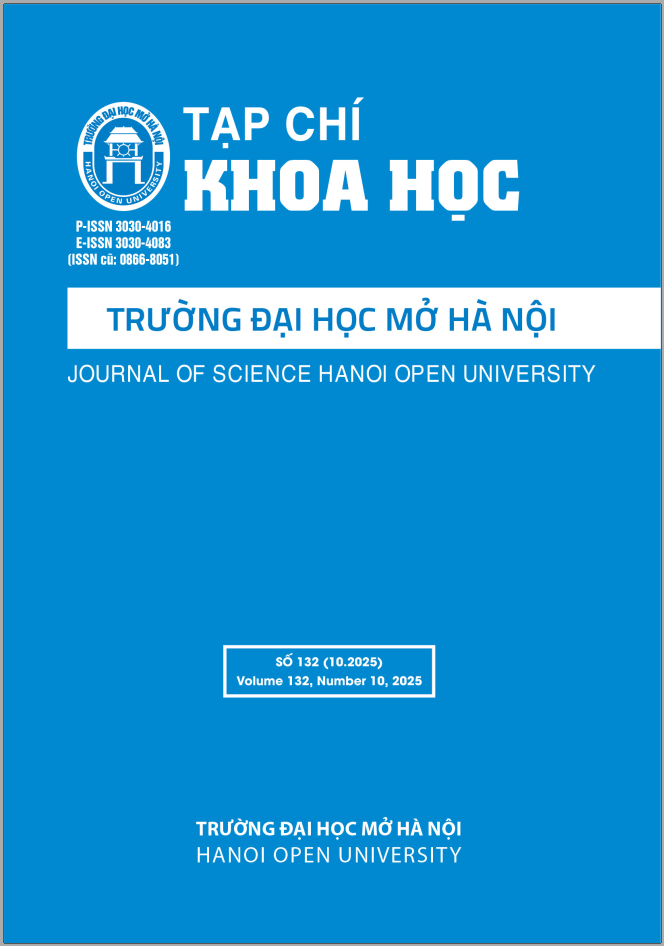ĐÁNH GIÁ HIỆU QUẢ SỬ DỤNG TINH DẦU LÁ CÂY TRÀ HOA VÀNG (CAMELLIA CHRYSANTHA) LÀM CHẤT BẢO QUẢN THỰC PHẨM THAY THẾ CÁC CHẤT BẢO QUẢN HÓA HỌC
DOI:
https://doi.org/10.59266/houjs.2025.850Từ khóa:
an toàn thực phẩm, chất bảo quản thực phẩm, chống oxy hóa, kháng khuẩn, tinh dầu trà hoa vàngTóm tắt
Nghiên cứu đánh giá tiềm năng của tinh dầu lá cây trà hoa vàng (Camellia chrysantha) như một chất bảo quản thực phẩm tự nhiên thay thế các chất bảo quản hóa học. Kết quả cho thấy tinh dầu chứa linalool (35%), phytol (8%), geranylacetone (7%) và methyl salicylate (6%), với khả năng kháng vi sinh vật mạnh (vùng ức chế 11-18 mm, MIC 0,1-0,5 mg/mL) và chống oxy hóa tốt (IC50 DPPH: 0,05 mg/mL). Tinh dầu kéo dài thời gian bảo quản thịt gà/lợn, bánh mì, bánh cốm, táo và chuối từ 3-6 ngày, giảm hư hỏng do vi sinh vật mà không ảnh hưởng đến cảm quan (màu sắc, mùi vị).
Tài liệu tham khảo
[1]. Bakkali, F., Averbeck, S., Averbeck, D., & Idaomar, M. (2008). Biological effects of essential oils - A review. Food and Chemical Toxicology, 46(2), 446-475.
[2]. Burt, S. (2004). Essential oils: Their antibacterial properties and potential applications in foods. International Journal of Food Microbiology, 94(3), 223-253.
[3]. Cui, F. L., Wei, Q., & Zhang, L. Y. (2013). Volatile compounds in two Camellia chrysantha (Hu) Tuyama species. Journal of Tea Science, 39, 294-298.
[4]. Davidson, P. M., & Naidu, A. S. (2000). Phyto-phenols. In A. S. Naidu (Ed.), Natural food antimicrobial (pp. 265- 294). CRC Press.
[5]. Dorman, H. J. D., & Deans, S. G. (2000). Antimicrobial agents from plants: Antibacterial activity of plant volatile oils. Journal of Applied Microbiology, 88(2), 308-316.
[6]. Ge, L., Lin, B., Mo, J., Chen, Q., Su, L., Li, Y., & Yang, K. (2018). Composition and antioxidant and antibacterial activities of essential oils from three yellow Camellia species. Trees, 33, 205-212.
[7]. Hyldgaard, M., Mygind, T., & Meyer, R. L. (2012). Essential oils in food preservation: Mode of action, synergies, and interactions with food matrix components. Frontiers in Microbiology, 3, 12.
[8]. Oussalah, M., Caillet, S., Saucier, L., & Lacroix, M. (2007). Inhibitory effects of selected plant essential oils on the growth of four pathogenic bacteria: Escheria coli O157:H7, Salmonella Typhimurium, Staphylococcus aureus and Listeria and monocytogenes. Food Control, 18(5), 414-420.
[9]. Tajkarimi, M. M., Ibrahim, S. A., & Cliver, D. O. (2010). Antimicrobial herb and spice compounds in food. Food Control, 21(9), 1199-1218.
[10]. Viuda-Martos, M., Ruiz-Navajas, Y., Fernández-López, J., & Pérez-Álvarez, J. A. (2008). Antifungal activity of lemon (Citrus limon L.), mandarin (Citrus reticulata L.), grapefruit (Citrus paradisi L.) and orange (Citrus sinensis L.) essential oils. Food Control, 19(12), 1130-1138.
[11]. Wei, J. B., Li, X., Song, H., Liang, Y. H., Pan, Y. Z., Ruan, J. Q., & Qin, Z. H. (2015). Characterization and determination of antioxidant components in the leaves of Camellia chrysantha based on composition- activity relationship approach. Journal of Food and Drug Analysis, 23(1), 40-48.
[12]. Zhang, L. L., Zeng, L. T., & Zhang, Y. (2014). The antimicrobial activity of essential oil from Camellia oleifera. Journal of Food Safety, 34(2), 123-129.
